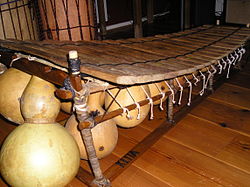 A fixed-key balafon, showing resonators with membrane holes | |
| Other names | balafo, bala, balaphone, balaphon, balaphong, balani, gyil, balangi |
|---|---|
| Classification | West African wooden Percussion idiophone with up to 21 keys |
| Hornbostel–Sachs classification | 111.212 (Sets of percussion sticks) |
| Developed | 12th century or earlier |
| Related instruments | |
| gyil, marimba, xylophone, gambang kayu | |
The balafon (pronounced /ˈbæləfɒn/, or, by analogy with xylophone etc., /ˈbæləfoʊn/) is a gourd-resonated xylophone, a type of struck idiophone.[1] It is closely associated with the neighbouring Mandé, Bwaba Bobo, Senoufo and Gur peoples of West Africa,[1][2] particularly the Guinean branch of the Mandinka ethnic group,[3] but is now found across West Africa from Guinea, Burkina Faso, Mali.[2] Its common name, balafon, is likely a European coinage combining its Mandinka name ߓߟߊ bala[4] with the word ߝߐ߲ fôn 'to speak'[2][5] or the Greek root phono.[1]
- ^ a b c Gourlay, K.A.; Durán, Lucy (2001). "Balo". Grove Music. doi:10.1093/gmo/9781561592630.article.01914. ISBN 978-1-56159-263-0. Retrieved 2019-07-12.
- ^ a b c Jessup, Lynne (1983). The Mandinka Balafon: An Introduction with Notation for Teachesting. Art Path Press. ISBN 9780916421045.
- ^ Charry, Eric (October 2000). Mande Music: Traditional and Modern Music of the Maninka and Mandinka of Western Africa. University of Chicago Press. ISBN 9780226101620.
- ^ Faya Ismael Tolno (September 2011). "Les Recherches linguistiques de l'école N'ko" (PDF). Dalou Kende (in French). No. 19. Kanjamadi. p. 7. Retrieved 17 December 2020.
- ^ Network, Canadian Heritage Information. "The Balafon by N'Gafien, Age 16". www.virtualmuseum.ca. Archived from the original on 2017-06-30. Retrieved 2019-07-12.